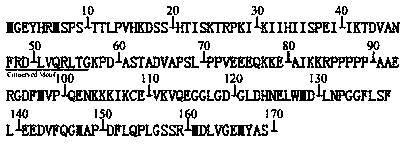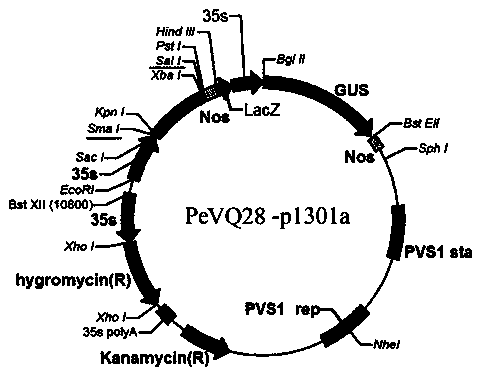Phyllostachys heterocycle PeVQ28 protein and coding gene and application thereof
A coding gene, technology of moso bamboo, applied in the fields of application, genetic engineering, plant gene improvement, etc., can solve the problem that the function of VQ gene has not been reported, and achieve the effects of enhanced salt resistance, improved salt resistance, and good application prospects
- Summary
- Abstract
- Description
- Claims
- Application Information
AI Technical Summary
Problems solved by technology
Method used
Image
Examples
Embodiment 1
[0025] A Protein Sequence Encoded by PeVQ28 Gene of Phyllostachys pubescens
[0026] Use primers software, carry out protein sequence translation (SEQID No.1) ( figure 1 ).
Embodiment 2
[0028] Analysis of the induced expression pattern of PeVQ28, a salt-tolerance-related gene in Phyllostachys pubescens
[0029] (1) Stress treatment and total RNA extraction
[0030] Use 100mM sodium chloride solution, 150mM sodium chloride solution and 200mM sodium chloride solution to irrigate annual moso bamboo seedlings respectively, keeping other nutritional conditions constant. Use scissors (cleaned and disinfected with 75% alcohol in advance) to take leaves of Phyllostachys pubescens 0, 1, 3, 6, 12 and 24 hours after various treatments, put them into 2mL dof tubes containing RNA protection solution, and store them for later use. The time period and sample plants were repeated 3 times. Total RNA was extracted by Trizol method, the detailed steps are as follows:
[0031] (1) Take out the spare leaves of Phyllostachys pubescens from the RNA protection solution, put them in the filter paper to absorb the protection solution as much as possible to avoid affecting it, transf...
Embodiment 3
[0074] Cloning of Salt Tolerance Related Gene PeVQ28 in Phyllostachys pubescens
[0075] According to the CDS sequence of the PeVQ28 gene published on the Moso bamboo genome website, the primers for PCR amplification of this fragment were designed, the upstream primer was added with a Sma I restriction site, and the downstream primer was added with a Sal I restriction site.
[0076] The primer sequences are as follows:
[0077] PeVQ28-F5′-ATA CCCGGG ATGGGGGAGTACCACAG-3′
[0078] PeVQ28-R5-GCC GTC GAC TTAAGATGCGTACATTTCAC-3′
[0079] The first-strand cDNA was reverse-transcribed from total RNA of leaves of Phyllostachys pubescens as a template, and PCR amplification was performed with upstream and downstream primers. The PCR reaction system is shown in Table 1:
[0080] Table 1
[0081]
[0082] The PCR reaction conditions were: pre-denaturation: 98°C 10min; denaturation: 98°C 10s; annealing: 58°C 30s; extension: 72°C 1min, 39 cycles; total extension: 72°C 10min.
[...
PUM
 Login to View More
Login to View More Abstract
Description
Claims
Application Information
 Login to View More
Login to View More - R&D
- Intellectual Property
- Life Sciences
- Materials
- Tech Scout
- Unparalleled Data Quality
- Higher Quality Content
- 60% Fewer Hallucinations
Browse by: Latest US Patents, China's latest patents, Technical Efficacy Thesaurus, Application Domain, Technology Topic, Popular Technical Reports.
© 2025 PatSnap. All rights reserved.Legal|Privacy policy|Modern Slavery Act Transparency Statement|Sitemap|About US| Contact US: help@patsnap.com



